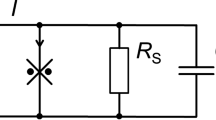Abstract
A comprehensive study has been made of some low-frequency electric and magnetic measurements which can be made using an rf-biased point-contact superconducting device of the symmetric two-hole type introduced by Zimmerman. Section 1 begins with a qualitative description of the phenomena which are observed and utilized in making the measurements. In Section 2 a semiquantitative and semiempirical analysis is made of the weakly superconducting system as it interacts with the rf field. Reasonable agreement between the analysis and experiment is obtained, thereby establishing a basis for optimization of conditions for measurement. Empirical data are also given as needed on coupling-coil characteristics. In Section 3 noise in the measuring system is discussed and the characteristics of the flux-locked loop used in the measurements introduced. It is shown that the total observed noise may be divided into at least three parts: one intrinsic to the sensor, one which reflects voltage noise in the amplifier, and one coupled into the instrument by the measuring circuit. The noise power spectra of the first two are shown to be comparable in an actual system. Below 100 Hz the spectrum, relative to the square of the flux quantum, is white and estimated by 10−8 Hz−1. In Section 4 the characteristics are discussed of a dc voltmeter using a flux-locked loop and having a relatively high input impedance and good noise figure. An experimental study of noise is presented. A particular case with subpicovolt sensitivity limited by Johnson noise is discussed. In Section 5 low-frequency ac measurements of resistance, self-inductance, and mutual inductance are discussed using a novel bridge circuit and the superconducting sensor in a flux-locked loop as null detector. The noise characteristics are described and studied experimentally. Extreme sensitivity is achieved, both in resistance and inductance. A 1 µω resistor may be measured with a precision of 1 part in 105 with subpicowatt power dissipation. Measurements of the mutual inductance due to a 1.6-mg crystal of CMN are described in which the crystal temperature was reduced to the millidegree region. In Section 6 measurements of static magnetization are discussed and the ideas applied to measurement of temperature using milligram quantities of CMN. Measurements using a pair of thermometers, one inside and the other outside the mixing chamber of a dilution refrigerator, are presented. In Section 7 the concept of a device-noise temperature is introduced and shown to be in the microdegree region. A very simple Johnson noise thermometer is then described. Measurements with this thermometer in the mixing chamber of a dilution refrigerator were carried out to 12 mK, the effective device temperature being measured to be +0.8±1.3mK. A qualitative experimental estimate places the actual device temperature well below 1 mdeg. In appendices a technical discussion of the flux-locked loop and of noise is given.
Similar content being viewed by others
References
B. D. Josephson,Advan. Phys. 14, 419 (1965).
J. E. Mercereau,Rev. Phys. Appl. 5, 13 (1970).
J. Clarke,Rev. Phys. Appl. 5, 32 (1970).
J. E. Zimmerman,J. Appl. Phys. 42, 30 (1971).
J. E. Lukens, R. J. Warburton, and W. W. Webb,J. Appl. Phys. 42, 27 (1971).
J. E. Zimmerman, P. Thiene, and J. T. Harding,J. Appl. Phys. 41, 1572 (1970).
R. L. Forgacs and A. Warnick,Rev. Sci. Instr. 38, 214 (1967).
A. H. Silver and J. E. Zimmerman,Phys. Rev. 157, 317 (1967).
M. B. Simmonds and W. H. Parker,J. Appl. Phys. 42, 38 (1971).
J. E. Zimmerman,Sensitivity Enhancement of Superconducting Quantum Interference Devices Through the Use of Fractional Turn Loops (preprint).
N. A. Pankratov, G. A. Zaitov, and I. A. Krebtov,Cryogenics 11, 138 (1971).
J. Clarke, W. E. Tennant, and D. Woody,J. Appl. Phys. 42(10), 3859 (1971).
E. C. Hirschkoff, O. G. Symko, and J. C. Wheatley,J. Low Temp. Phys. 5(2), 155 (1971).
E. C. Hirschkoff, O. G. Symko, and J. C. Wheatley,J. Low Temp. Phys. 4, 111 (1971).
W. R. Abel, A. C. Anderson, and J. C. Wheatley,Rev. Sci. Instr. 35, 444 (1964).
E. C. Hirschkoff, O. G. Symko, L. L. Vant-Hull, and J. C. Wheatley,J. Low Temp. Phys. 2, 653 (1970).
R. A. Kamper and J. E. Zimmerman,J. Appl. Phys. 42, 132 (1971).
R. A. Kamper, J. D. Siegwarth, R. Radebaugh, and J. E. Zimmerman,IEEE Proc. Letters, to be published.
A. C. Mota,Rev. Sci. Instr. 42(10), 1541 (1971).
B. P. Lathi,Random Signals and Communication Theory (International Textbook Co., London, 1968), p. 326.
J. E. Zimmerman, private communication.
Author information
Authors and Affiliations
Additional information
This work has been supported by the U.S. Atomic Energy Commission under Contract No. AT(04-3)-34, P.A. 143.
Rights and permissions
About this article
Cite this article
Giffard, R.P., Webb, R.A. & Wheatley, J.C. Principles and methods of low-frequency electric and magnetic measurements using an rf-biased point-contact superconducting device. J Low Temp Phys 6, 533–610 (1972). https://doi.org/10.1007/BF00644085
Received:
Issue Date:
DOI: https://doi.org/10.1007/BF00644085




